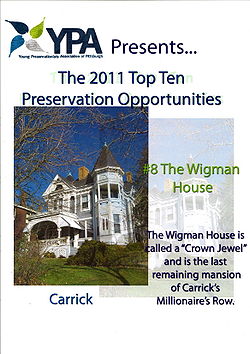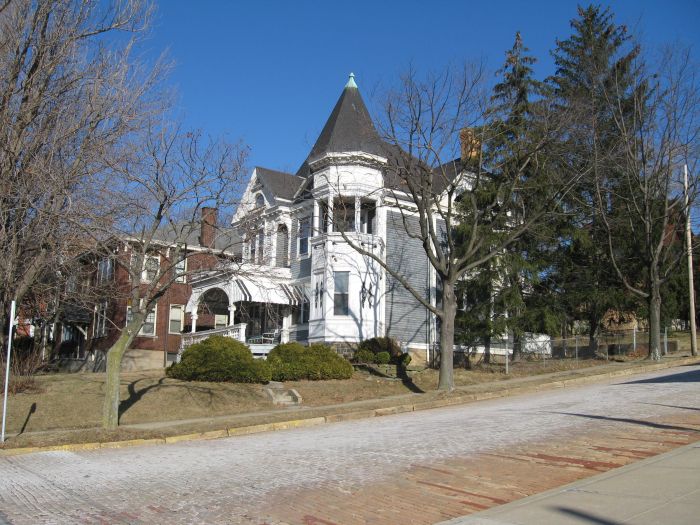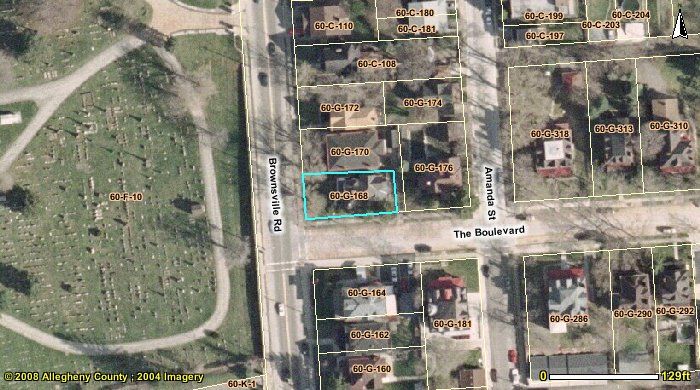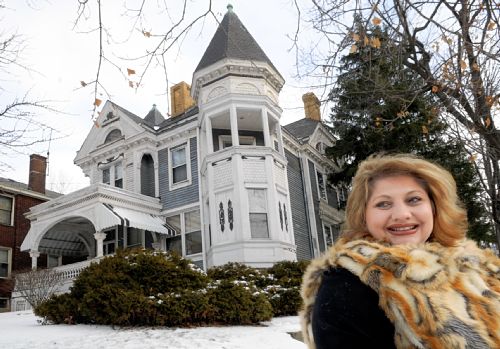Difference between revisions of "Wigman House"
(→YPA Releases 2011 Top Ten List) |
|||
| Line 104: | Line 104: | ||
The criteria used to select the Top Ten List include the following: | The criteria used to select the Top Ten List include the following: | ||
| + | |||
1. 50-year Threshold (is it 50 years old or older); | 1. 50-year Threshold (is it 50 years old or older); | ||
| + | |||
2. Historic & Architectural Significance; | 2. Historic & Architectural Significance; | ||
| + | |||
3. Threats to the Site; | 3. Threats to the Site; | ||
| + | |||
4. Community Input; and | 4. Community Input; and | ||
| + | |||
5. Feasibility of the Solution. | 5. Feasibility of the Solution. | ||
| − | Below are the Top Ten Best Preservation Opportunities in the Pittsburgh Area for 2011. | + | |
| + | Below are the Top Ten Best Preservation Opportunities in the Pittsburgh Area for 2011. | ||
| + | |||
10. Connellsville Armory, Connellsville, Fayette County | 10. Connellsville Armory, Connellsville, Fayette County | ||
| + | |||
9. Saints Peter and Paul Church, East Liberty (Pittsburgh) | 9. Saints Peter and Paul Church, East Liberty (Pittsburgh) | ||
| + | |||
| + | [[File:Wigman.jpg|250px]] | ||
8. Wigman House, Carrick (Pittsburgh) | 8. Wigman House, Carrick (Pittsburgh) | ||
| + | |||
7. Stables Building, Allegheny West (Pittsburgh) | 7. Stables Building, Allegheny West (Pittsburgh) | ||
| + | |||
6. Westinghouse Atom Smasher, Forest Hills, Allegheny County | 6. Westinghouse Atom Smasher, Forest Hills, Allegheny County | ||
| + | |||
5. Hipwell Building, Alleghney West (Pittsburgh) | 5. Hipwell Building, Alleghney West (Pittsburgh) | ||
| + | |||
4. Old Masons Building, Uniontown, Fayette County | 4. Old Masons Building, Uniontown, Fayette County | ||
| + | |||
3. Highland Building, East Liberty (Pittsburgh) | 3. Highland Building, East Liberty (Pittsburgh) | ||
| + | |||
2. Grand Theatre, Elizabeth (Pittsburgh) | 2. Grand Theatre, Elizabeth (Pittsburgh) | ||
| + | |||
1. Main Street Waynesburg, Waynesburg, Greene County (featured below) | 1. Main Street Waynesburg, Waynesburg, Greene County (featured below) | ||
Revision as of 16:28, 7 May 2011
Contents
- 1 For over 100 years this house didn't have a name it was simply our Crown Jewel. Through our research into this Queen Anne Victorian house we can now call it "The Wigman House" after the owner and builder, William Wigman of Wigman Lumber. This is our Crown Jewel Victorian and is the last standing example of our past. Let's hope that it never gets destroyed by anyone!
- 2 Description of the Wigman House, American Queen Anne style, 1425 Brownsville Road, Pittsburgh, PA 15210
- 3 History of the Wigman House, a Queen Anne Victorian,
- 4 AKA 1425 Brownsville Road, Pittsburgh, PA 15210
- 5 Some in Carrick strive to save Victorian house
- 6 Young Preservationists Association Award
- 7 YPA Releases 2011 Top Ten List
For over 100 years this house didn't have a name it was simply our Crown Jewel. Through our research into this Queen Anne Victorian house we can now call it "The Wigman House" after the owner and builder, William Wigman of Wigman Lumber. This is our Crown Jewel Victorian and is the last standing example of our past. Let's hope that it never gets destroyed by anyone!
Description of the Wigman House, American Queen Anne style, 1425 Brownsville Road, Pittsburgh, PA 15210
The Wigman House at 1425 Brownsville Road was built to the Queen Anne Style buildings and is an excellent example of the style containing almost all of the classic elements of the style. The Queen Ann Style buildings in America came into vogue in the 1880s and this house was built in or around 1902. Because the popularity of high Queen Anne Style waned in the early 1900s this house is the only example of that architectural style existing in the immediate area.
Many of the distinctive features of American Queen Anne style can be found in the Wigman house including asymmetrical facade; dominant front-facing gable, cantilevered out beyond the plane of the wall below; overhanging eaves; a polygonal tower; shaped and Dutch gables; a porch covering part or all of the front facade, including the primary entrance area; a second-story porch or balconies; pedimented porches; differing wall textures, such as patterned wood shingles shaped into varying designs, including resembling fish scales, relief panels; dentils; classical columns; spindle work; oriel and bay windows; a large leaded stained glass window; monumental chimneys; painted balustrades; and a slate roof.
The interior of the house reflects the best wood, doors, woodwork and framing. Even the stained glass windows have wooden framing around each of the three windows for added support and appearance. The pocket doors between the living room parlor and the dining room function with ease. The six working fireplaces fine carved wood, marble or slate indicate the details of wealth that went into the house.
History of the Wigman House, a Queen Anne Victorian,
AKA 1425 Brownsville Road, Pittsburgh, PA 15210
The history of 1425 Brownsville Road begins on August 15, 1890 when Ferdinand Benz buys Lot Number 20 in a plan called the South View Place, for $300. The lot was in a plan laid out by the Birmingham Land Improvement Company in Baldwin Township, now the neighborhood of Carrick in the city of Pittsburgh, PA. The property fronted what was known as Southern Avenue now Brownsville Road and The Boulevard.
Ferdinand Benz was the best known German banker of Pittsburgh . He was a member of the contracting firm of L. Benz Brothers, an organization which built many buildings in Pittsburgh city and Pittsburgh’s South Side, including the People’s Trust Company on 18th and Carson, South Side Market house in 1893. Mr. Benz was also was Vice President of the German Savings and Deposit Company on the South Side and a Director in the First National Bank of Birmingham, as well as a stockholder in almost every bank in Pittsburgh. He had a very large fortune when he died according to the obituary in The New York Times.1
The choice of Baldwin Township’s Carrick section to buy this property perhaps for his home can only be assumed at this point. However, since he was a Director in the First National Bank of Birmingham he had to have known the President Thomas H. Sankey who also was to build a huge home on The Boulevard.
Carrick’s formation as a Borough in 1904 was described as an area “inhabited by wealthy South Side businessmen” so such was the choice of land for a grand home on the new elegant street called that was simply named “The Boulevard.”
Ferdinand Benz of the L. Benz Brothers Company was single and did not build on this lot. Perhaps Carrick was too far from his businesses and buildings or maybe he was simply a land speculator because sold the lot to Gwendolen P. Wigman, wife of William H. Wigman, on April 2, 1897 for $1,450. Gwendolen P. Wigman then transferred the lot for one dollar to her husband later that year. On November 28th, 1902, Julius Frey sold his property, Lot Number 19 next to Lot Number 20, for the sum of $3,000.
William H. Wigman was either the owner, or the son of owner, of a very prosperous lumber company at 48 South 18th Street on the South Side, Wigman Lumber. The Pittsburgh Street Directory of 1912 lists his home as Baldwin Twp indicating that he built the home sometime before that year and probably shortly after he bought the two lots large enough for his grand Queen Anne style home.
Supporting the evidence of the home being built before 1905 is indicated in the G. M. Hopkins Maps of 1896 and 1905. In fact between those two dates not only were several mansions built on The Boulevard, a new school for the community, Quentin Roosevelt School can be found. Truly this was fast becoming the location to live in the South Hills.
The Wigman House at 1425 Brownsville Road reflects the utilization of the best the William Wigman Lumber Company had to offer to design and build this home in the classic American Queen Anne style popular in the late 1800s and early 1900s. The ornate exterior wood trim, the interior doors, woodwork and framing, the pocket doors and even the closet doors are still illustrate how detailed the builder and architect built the home. The woodwork is wood that displays the real graining, without the staining to produce faux stained wood as common in less expensive homes of the time. The large chain hung window/door entrance to the turret balcony reflects the ingenuity of design. The original stained glass windows, which are held by rich wooden framing, indicate great wealth and expertise.
On March 19, 1919, William H. Wigman sold the house to William Wigman, for $1 and this deed indicate Lots 19 and 20. This was possibly a formality because on June 12, 1919, William Wigman sells the property to Mary E. Herrmann for $8,000. Mary E. Herrmann transfers the same property to Walter J. Herrmann, her son, on September 16, 1941. Walter J. Herrmann died on April 21, 1942 and, by will, gave the property to his mother, but his mother died before he did, so the heirs of Walter J. Hermann’s divided the estate, viz (deed language): Mary Herrmann, his widow, and William J. Herrmann and Arthur Herrmann, his sons. By deed dated February 1. 1951 granted and conveyed all their interest to Arthur Herrmann.
On February 23, 1952, Arthur Herrmann sells this property to Regis L. McClory, et. ux, for $11.750. The house is currently owned by Regis L. McClory, deceased, and his wife, Eleanor Marie McClory.
Some in Carrick strive to save Victorian house
Friday, December 24, 2010
By Diana Nelson Jones, Pittsburgh Post-Gazette
Julia Tomasic of the Carrick-Overbrook Historical Society is trying to save the last great Victorian home in Carrick, at 1425 Brownsville Road, by nominating it for historic status.
At one corner of Brownsville Road and The Boulevard in Carrick sits state Rep. Harry Readshaw's funeral home. Across The Boulevard, a late-19th-century Queen Anne house is the last of the grand Victorians remaining on the main drag.
Its owners want to sell and may have a buyer in Mr. Readshaw, who said he is interested in buying the property and that demolishing it to provide parking "might be a decision to be considered."
Mr. Readshaw's interest has spurred the Carrick-Overbrook Historical Society to try to save the house.
Historical society member John Rudiak documented the property and this week nominated it for historical designation. He said demolition of the house would put an end to any evidence of Carrick's Victorian heritage.
The nomination would stall any plan to demolish the house until the Historic Review Commission could determine whether it is eligible, based on a set of federal criteria. Eligibility ultimately must be decided by Pittsburgh City Council. Historic status regulates changes to a building's exterior but not to its interior.
Richard C. Gasior, whose wife's family has owned the four-bedroom home since 1952, said the family needs to sell it and has been advised that $150,000 would be a fair price. "If I can't get anybody to buy it, I'm going to go with Readshaw," he said.
Known as the Wigman House, it was built in the late 1800s by William Wigman, owner of Wigman Lumber on the South Side. The nomination states that it is "the last remaining example of several homes of the wealthy South Side gentry who lived in Carrick."
The current owners gave a tour to members of the Carrick-Overbrook Historical Society several weeks ago, said Julia Tomasic, a founding member of the society.
"We'd love to buy it, but there are just three of us" in the society, which has no money, Ms. Tomasic said. "It has a brand-new furnace, a slate roof and the interior woodwork and walls in original hardwood, with six fireplaces, including one converted for wood. Nothing has been done to alter it."
According to the Pittsburgh code for historic preservation, a property must meet at least one of 10 criteria to be eligible for preservation.
The nomination papers cite several possible eligibilities. One is that the home, a classic American Queen Anne, has not been modified. Its features include an asymmetrical facade, front-facing gable, overhanging eaves, polygonal tower, shaped and Dutch gables, a porch covering part or all of the front facade, a second-story porch or balconies, pedimented porches, dentils, spindles, differing wall textures including fish scales, and oriel and bay windows.
"We heard rumors for a year that Harry [Readshaw] would buy it to tear it down, and we thought it was a joke because we consider Harry a friend of the neighborhood," Ms. Tomasic said. "Parking? You park on the street. We're city people."
"It's not like I'm sitting here champing at the bit with a sledge hammer," Mr. Readshaw, D-Carrick, said, "but business is business and any business is looking to improve its services."
"And if we don't get it, what happens to it?" he said. "Somebody dying to live in a big Victorian who would be a wonderful neighbor would be a positive." A Section 8 landlord is a more likely prospect, he said, adding, "The 29th Ward has been inundated with Section 8 housing."
Brownsville Road once had several grand Victorian homes owned by prominent businessmen. As a hilltop neighborhood, Carrick was a refuge from the smoky city. Through much of the 20th century, it was solidly middle class and owner-occupied. It remains so, but some of its stability is eroding.
In its argument for historic status, the historical society calls the Wigman House the most prominent home in Carrick, "our crown jewel Victorian." Losing it would be a shock, the document reads, and "one more loss that we cannot sustain."
Diana Nelson Jones: djones@post-gazette.com or 412-263-1626. Read her blog City Walkabout at http://blogs.sites.post-gazette.com.
First published on December 24, 2010 at 12:00 am
Young Preservationists Association Award
YPA Releases 2011 Top Ten List
Posted On: February 24, 2011
The Young Preservationists Association has released its 2011 list of the Top Ten Best Preservation Opportunities, which marks the start of National Historic Preservation Month (May). The list, released annually, includes endangered historic sites in the Pittsburgh area that are good candidates for preservation and reuse.
YPA will release a printed copy of its 2011 Top Ten report at its annual Preservation Month Celebration on Friday, May 6th, at the Paramount Pictures Film Exchange, from 6 to 8 p.m. Event details are on YPA’s website, May 6
Since 2003, YPA has celebrated historic preservation with its annual list of the Top Ten Best Preservation Opportunities in the Pittsburgh Area. The list, compiled from nominations received from various individuals and organizations, is designed to encourage investment in historic sites throughout the nine-county southwestern Pennsylvania region. The list has been used by property owners to draw positive attention to their properties, raise investment funds, secure grants, and generate political goodwill for their historic sites.
In fact, since YPA released its first Top Ten List in 2003, more than $80 million has been invested into properties placed on YPA’s Top 10 List, including the creation of an estimated 1,245 construction and trade-related jobs, 230 housing units, and $750,000 in additional annual wage tax revenue is yielded to state and local municipalities, as documented in YPA’s 2010 report, “The Economic Impact of Historic Preservation in Southwestern Pennsylvania: Jobs that cannot be outsourced.” Download the Economic Impact Report here: Economic Impact in SW PA.
The criteria used to select the Top Ten List include the following:
1. 50-year Threshold (is it 50 years old or older);
2. Historic & Architectural Significance;
3. Threats to the Site;
4. Community Input; and
5. Feasibility of the Solution.
Below are the Top Ten Best Preservation Opportunities in the Pittsburgh Area for 2011.
10. Connellsville Armory, Connellsville, Fayette County
9. Saints Peter and Paul Church, East Liberty (Pittsburgh)
 8. Wigman House, Carrick (Pittsburgh)
8. Wigman House, Carrick (Pittsburgh)
7. Stables Building, Allegheny West (Pittsburgh)
6. Westinghouse Atom Smasher, Forest Hills, Allegheny County
5. Hipwell Building, Alleghney West (Pittsburgh)
4. Old Masons Building, Uniontown, Fayette County
3. Highland Building, East Liberty (Pittsburgh)
2. Grand Theatre, Elizabeth (Pittsburgh)
1. Main Street Waynesburg, Waynesburg, Greene County (featured below)
A low-res. copy of the final report can be found here: Celebrate Historic Treasures in Southwestern Pennsylvania: Top Ten Best Historic Preservation Opportunities in the Pittsburgh Area 2011
Past sites have included the Armstrong Cork Factory, Union Project, and the New Granada Theatre, all of which have been restored or stabilized.
Stay tuned to YPA’s Facebook Page for more details.
Posted by Dan Holland | Filed Under Blog, Events


